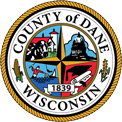
Hazards can come in many forms. Natural hazards, like floods or winter storms, can affect your family's access to food and electricity. Hazardous materials emergencies, like the release of a dangerous chemical into our community, can result in health problems and property damage. Read the information below for details about how to prepare for and respond to potential hazards in Dane County.
From winter storms to heat waves, Dane County is susceptible to a variety of natural hazards. These varying emergencies call for varying responses — responses you should be familiar with. Becoming knowledgeable of disasters now can protect you from them in the future. Browse our quick tips for more information.
The occurrence and impact of flooding are issues of increasing concern to Dane County residents. Severe flood damages over the past couple decades (notably in 1996, 2000, and 2018) have cost local governments and property owners tens of millions of dollars. Smaller scale, localized flooding occurs on an annual basis. The potential exists for future damages to the County's farmland, crops, homes, shorelines, and roads.
There are many actions that communities and individuals can take to reduce their risks of suffering flood damage. Here are some tips on how to reduce flood damage to property, how to stay safe during flooding, and how to recover when floods occur.
Detailed information on the flood hazard in Dane County is available in the Flood Risk Assessment section of the County's Natural Hazard Mitigation Plan. Additional information on flooding facts and initiatives in Dane County is available from Dane County Land and Water Resources Department.
Below are additional resources:
The winter months in Wisconsin can be a great time to spend outdoors, but winter storms can kill. Each year, thousands are killed or injured by automobile accidents, home fires, over-exertion, exposure, carbon monoxide poisoning, falls, and electrocution from downed wires. View the tips below to see how you can protect yourself and your family.
For as cold as Wisconsin can get in the winter, it can certainly heat back up in the summer — sometimes to a dangerous level.
Lightning, winds, rain, hail, and tornados are all hazards that can come along with a thunderstorm. Staying informed about current weather conditions and preparing your family and home for adverse weather are the best ways to prevent a thunderstorm-related tragedy. Here are some additional tips:
If lightning is striking nearby you should avoid direct contact with other people, get into a ditch or a shallow depression, remove all metal objects, and crouch down (feet together and hands on your knees).
Wisconsin's tornado season runs from April through September. The greatest numbers of tornadoes have occurred in May, June, and July. Wisconsin averages almost 20 tornadoes per year. Most tornado damage is caused by violent winds. Many injuries and deaths result from flying debris. When a tornado threatens, immediate action can save your life. These tips will also help:
Dane County Emergency Management (DCEM), in cooperation with state and local agencies, identifies the potential for hazardous materials emergencies in Dane County and develops policies and procedures for responding to and recovering from hazardous materials emergencies if they were to occur. This planning is paramount to protect the community from a potentially harmful and life-threatening release of a hazardous material.
The Dane County Local Emergency Planning Committee (LEPC) develops policies, procedures, and emergency plans for the prevention, response to, and recovery from hazardous materials incidents in compliance with the requirements of the Federal Superfund Amendments and Reauthorization Act of 1986 (SARA—Title III).
Further information is available regarding chemical emergency preparedness by contacting the Dane County Emergency Management Hazardous Materials Planner at (608) 266-9051.
The Dane County Clean Sweep Facility is located at the Dane County Landfill Site and operates year round. The facility accepts hazardous chemicals from Dane County residents, farms, and some businesses. Clean Sweep also offers an electronics recycling program for Dane County residents. The program lowers the environmental risks associated with improper disposal of hazardous materials. More information is available here.